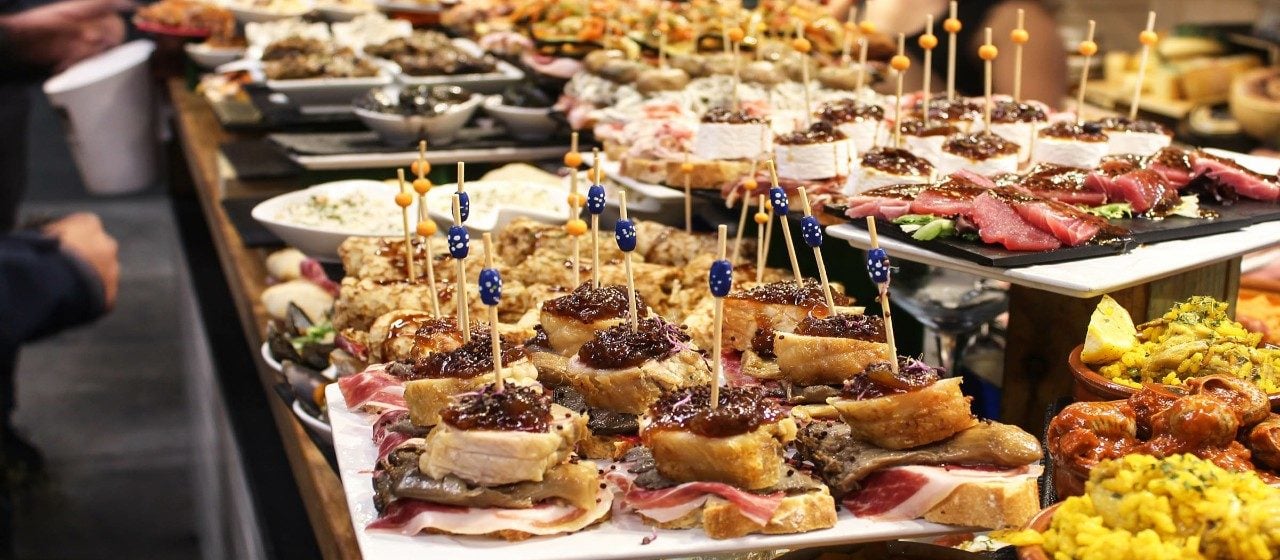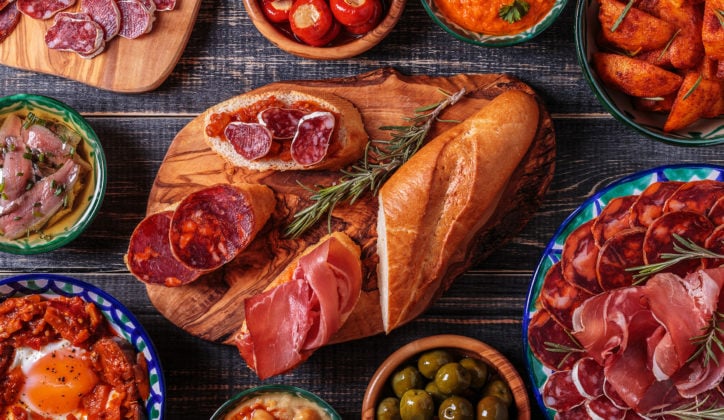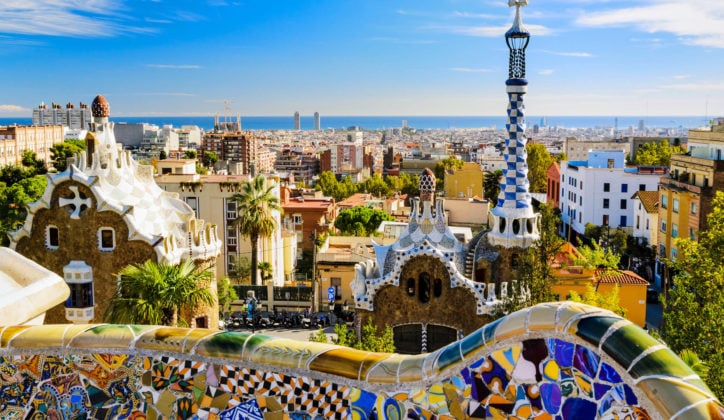Published on: March 23rd, 2022
Last modified: December 28th, 2023
Spain is home to one of the world’s most delicious and diverse cuisines. From the towering peaks of Asturias to the beautiful beaches of Cádiz, each region has its own culinary specialties.
But if there’s one thing the whole country has in common, it’s tapas.
Tapas have become synonymous with Spanish food, inspiring all kinds of creative takes on the concept of ‘small plates’. To experience tapas culture in its truest form, though, you have to head straight to the source.
We believe there’s no better way to get to know Spain than by tasting its most famous dishes – from Basque pintxos and patatas bravas to ham croquettes and skewered anchovies. If you’re ready to dive into Spanish tapas culture, here’s where to start.

What Are Tapas?
Tapas are small plates of food traditionally served with drinks in Spanish bars. They’re incredibly easy to find – Spain has more bars per capita than any other country in Europe, after all. Spanish tapas often feature potatoes, cured ham, sausages, cheese and other fresh produce.
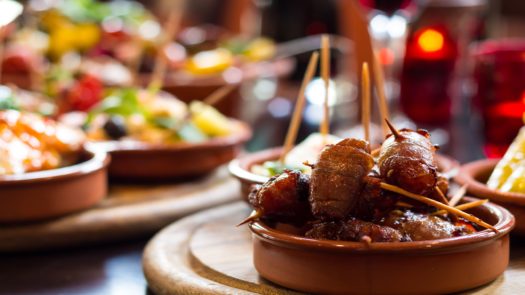
Where did tapas come from?
There are many theories about the origin of tapas. Some people trace them to King Alfonso X of Castile, who ate small amounts of food while recovering from an illness. Others credit rural bar owners encouraging local farmers to spend more time at their bars.
As for the word ‘tapas’, the generally accepted theory is that bartenders used to place small plates on top of drinks to keep out flies. The Spanish word for ‘cover’ is tapar – so once they started adding food to these little plates, the dishes became known as ‘tapas’.

What makes Spanish tapas unique?
Tapas are one of the most widespread and well-known aspects of Spanish cuisine – and one of the most imitated. Restaurants across the world have put their own twists on this concept, and in many places, ‘tapas’ simply means small dishes to share.
In Spain, however, tapas are much more than a portion size. They’re the centrepiece of a whole culinary culture, in which meals are social gatherings and food is a tool for bringing people together.
Authentic Spanish tapas are usually simple dishes made with locally sourced, high-quality ingredients. Traditional tapas tend to be humble and hearty: fried potatoes with runny eggs and chorizo, blistered peppers with flaky salt, sizzling prawns soaked in garlic and olive oil…
If you’re feeling a bit more adventurous, there are plenty of creative Spanish chefs putting their own spin on classic recipes. It’s no coincidence that Spain is full of Michelin-starred restaurants, many of them masterfully blending tradition and innovation.
To get the full picture of Spanish tapas culture, we suggest trying a bit of everything, – from the century-old bar down the street to the trendiest new tapas concept.

When and How to Order Tapas
In Spain, dinner tends to be a relatively light meal, often featuring tapas. These are usually shared, allowing everyone to taste several dishes rather than ordering their own meal. And instead of settling down for a night out at one restaurant, many Spaniards prefer to tapear, or hop from bar to bar having a drink and a tapa or two at each place.
We highly recommend following in their footsteps when you visit Spain. To discover all the best spots with a local expert, book a tapas tour – or create your own custom tapas crawl by visiting a few different places. We’re always happy to help with our favourite recommendations.
Keep in mind that the Spanish eating schedule is a bit different to what you might be used to; lunch is served around 2 or 3 p.m., and most people don’t eat dinner until 9 or 10 p.m. Many tapas bars don’t even open until 8 p.m., so it’s a good idea to factor in an afternoon snack, or merienda, to hold you over until it’s tapas time.
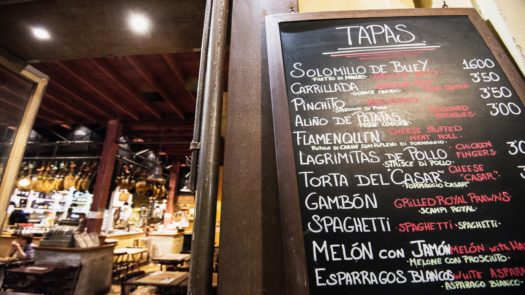
Are tapas free?
In some parts of Spain, tapas are still served for free with every round of drinks. The Andalusian city of Granada is especially famous for its free tapas culture. In most places, however, you have to pay for tapas – although this also means you get to choose which ones you want.
No matter where you are, you’ll usually get a dish of olives or potato chips with your beer or wine, and then have the option to order more substantial tapas separately.
If you do go to a bar where the tapas are free, keep in mind that they’ll usually get bigger and better with each round of drinks. This means it pays off to hang around at the same place for a while. It’s also a great way to try new things, as you never know exactly what you’re going to get!
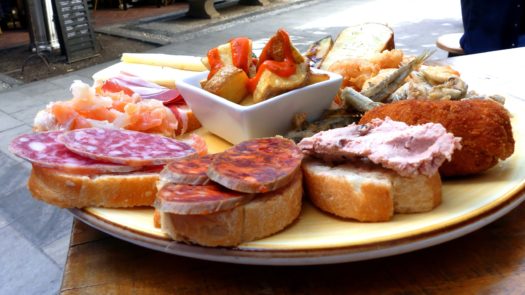
Tapas Culture Across Spain
While you’ll find tapas everywhere in Spain, they can look and taste totally different in various parts of the country.
1. Basque tapas
The Basque Country has its own take on tapas, known as pintxos. The classic pintxo consists of a small slice of bread topped with some kind of food: olives and anchovies, Spanish tortilla, roasted red peppers… the options are endless. These pintxos are often displayed on the bar for you to pick and choose, but most places also offer a menu of made-to-order pintxos that take the basic tapa to new heights (think cheesy risotto or melt-in-your-mouth pork belly).
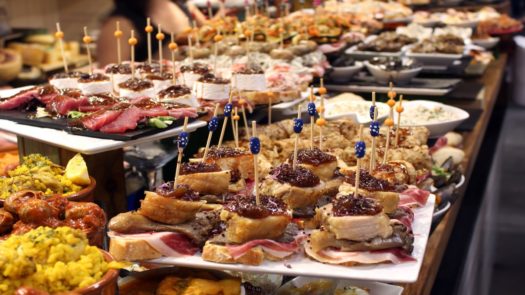
2. Andalusian tapas
Andalusia also has a thriving tapas culture – and not only in Granada. Some people say Seville is the best place in the world for tapas, thanks to specialties like rabo de toro (stewed oxtail) and salmorejo (cold tomato soup). The beach towns of Cádiz and Málaga offer up their own temptations, such as tortillitas de camarones (prawn fritters) and pescaíto frito (fried fish).
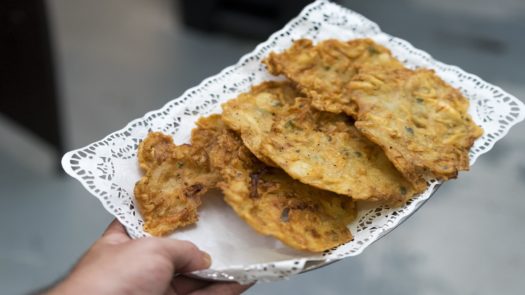
3. Madrid tapas
If you want to try tapas from all over Spain, Madrid is your best bet. The capital city is a tapas lover’s paradise, with dozens of traditional tabernas and trendy bars serving authentic food from Galicia, Asturias, Extremadura, Valencia and pretty much everywhere else.
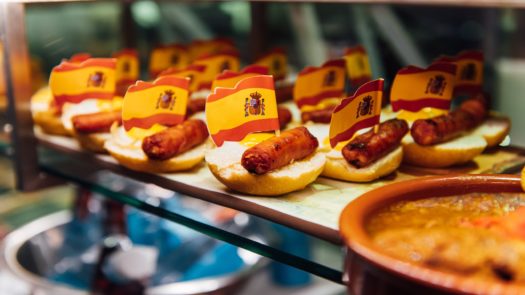
A True Taste of Spain
If you ask us, no trip to Spain is complete without plenty of tapas. And no matter how many times you visit or how many places you go, you’ll never run out of new things to try – the immense variety of Spanish tapas is one of our favourite things about them.
Ultimately, tapas are much more than a type of dish; they’re a window into Spanish culture and history, and a delicious representation of what makes this country so special. ¡Buen provecho!
